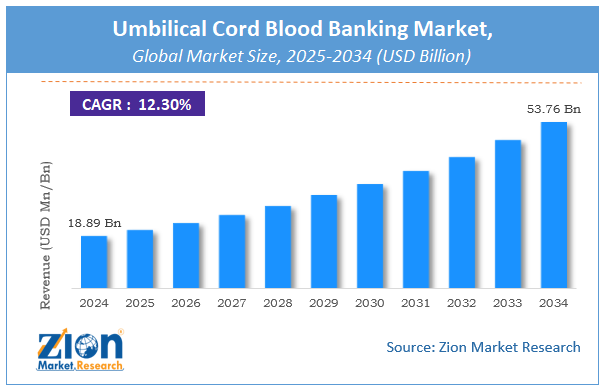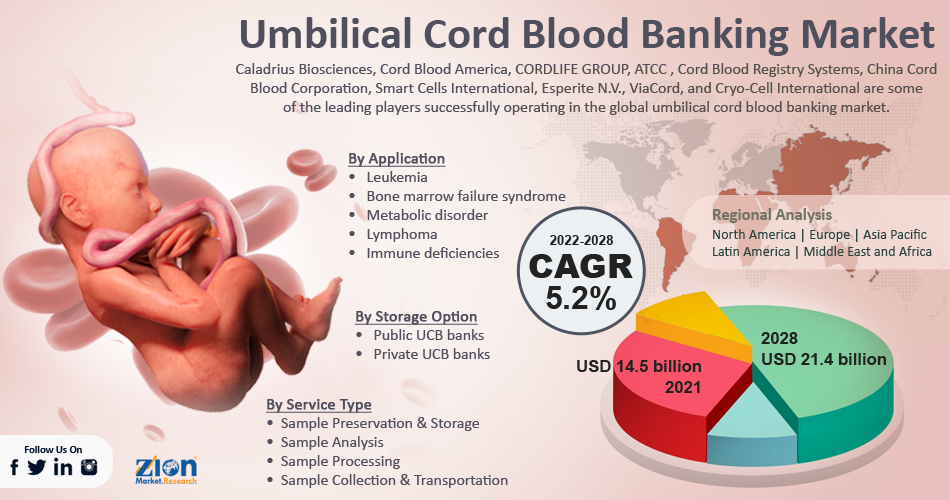Umbilical Cord Blood Banking Market Size, Share, Trends, and Forecast 2028

Umbilical Cord Blood Banking Market By Storage Option (Private UCB Banks and Public UCB Banks), By Application (Metabolic Disorder, Bone Marrow Failure Syndrome, Leukemia, Immune Deficiencies, and Lymphoma), By Service Type (Sample Collection & Transportation, Sample Processing, Sample Analysis, Sample Preservation, and Storage), and By Region - Global and Regional Industry Overview, Market Size, Market Intelligence, Comprehensive Analysis, Historical Data, and Forecasts 2022 - 2028
| Market Size in 2021 | Market Forecast in 2028 | CAGR (in %) | Base Year |
|---|---|---|---|
| USD 14.5 Billion | USD 21.4 Billion | 5.2% | 2021 |
Umbilical Cord Blood Banking Industry Prospective:
The global umbilical cord blood banking market size was worth around USD 14.5 billion in 2021 and is estimated to grow to about USD 21.4 billion by 2028, with a compound annual growth rate (CAGR) of approximately 5.2 percent over the forecast period.
The report analyzes the umbilical cord blood banking market’s drivers, restraints/challenges, and the effect they have on the demands during the projection period. In addition, the report explores emerging opportunities in the umbilical cord blood banking market.
Umbilical Cord Blood Banking Market: Overview
The prompt preservation of a baby's cord blood after birth is known as umbilical cord blood banking. Over 80 genetic diseases can be treated with stem cells from umbilical cord blood, which is a major source of these cells. Chronic diseases including immunological disorders, blood diseases, diabetes, and cancer can be treated with cord blood stem cells. Even while only a tiny amount of cord blood can be extracted out of a single umbilical cord, it is the only form of stem cell that can be preserved for use in the future and includes a substantial number of stem cells. These cells may be kept in cord blood banks for an average of 20 to 25 years and are obtained from hospitals & nursing homes for use in the future.
COVID-19 Impact:
Numerous businesses in the global market for umbilical cord blood banking had to temporarily suspend operations as a result of the COVID-19 pandemic in order to adhere to new rules put in place by the government to stop the disease's spread. The global market was thus immediately impacted by this suspension in operations in terms of revenue flow. In addition to this, due to a shortage of labor and raw resources during the lockdown, industrial goods production has also stopped. Furthermore, businesses who operate in this industry do not get any new consignments thereby impacting the market growth. However, with ease in restrictions and all the operations coming on track, the market is expected to witness a gradual rebound throughout the projected period.
Umbilical Cord Blood Banking Market: Growth Drivers
Growing incidence of blood disorders to foster the market growth
Blood and blood-forming organs are related to blood disease. The prevalence of these disorders is continually increasing and includes hemophilia, lymphoma, leukemia, sickle cell anemia, thalassemia, and others. The need for cord blood cells is expanding as a result of the exponentially increasing occurrence of blood disorders especially leukemia across the world. Worldwide, an estimated 1.2 million instances of blood cancer are recorded each year, along with more than 720,000 related fatalities.
More and more blood cancer patients are being treated using cord blood. Government and commercial institutions are funding stem cell treatments for the treatment of cancer. Additionally, the development of the sector will be positively impacted by supportive government efforts, quickly advancing healthcare infrastructure, and increased R&D for the treatment & diagnostics of different blood diseases. All of these factors are expected to boost the growth of the global umbilical cord blood banking market.
Umbilical Cord Blood Banking Market: Restraints
High cost of umbilical cord banking to restrain market growth in emerging economies
The market may be slowed down by the growing cost of umbilical cord blood banking. Fees for private cord blood banking can range from $1,000 to $2,000. Additionally, a patient must spend $100 to $175 in maintenance and storage fees annually. Additionally, cord blood banking expenses are not covered by and reimbursed by health insurance providers. Thus, the high cost of cord blood banking and the absence of insurance may limit business growth throughout the anticipated time period.
Umbilical Cord Blood Banking Market: Opportunities
Increasing number of clinical trials on stem cells derived from umbilical cord blood to fuel the market expansion
Researchers are using cord blood-derived stem cells in clinical studies to test potential cures for immunological problems, neurological disorders, and muscular ailments. Included in this is autism, for which a recent publication from American researchers revealed that children in the trial improved significantly after receiving cord blood infusions for 12 and 24 weeks. In 10 newborns having heart surgery, pilot research evaluated the safety and efficacy of replacing postoperative blood loss with autologous umbilical cord blood (AUCB) transfusion. Further, even neonates with brain damage are candidates for therapy with cord blood. In a phase I clinical investigation, umbilical cord blood transplantation was found to be both safe and efficacious for treating severe intraventricular hemorrhage in premature infants. Thus, growing studies and clinical trials are estimated to hold numerous opportunities for the growth of the global umbilical cord blood banking market during the forecast period.
Umbilical Cord Blood Banking Market: Challenges.
Strict licensing and accreditation requirements to pose a major challenge to market growth
Umbilical Cord Blood Banks (UCB) are only authorized with a license and under the supervision of authorized regulatory bodies. In addition to this, the umbilical cord blood banks are required to abide by strict rules set up for the gathering, examination, testing, storing, banking, and distribution of saved units. Moreover, most international bodies including the American Society for Blood and Marrow Transplant, American Academy of Pediatrician, European Group on Ethics in Science and New Technologies, and many more for future self-use, do not advise routine private banking as genetic abnormalities cannot be treated with an autologous stem cell transplant (using a patient's own cord blood). All such factors are likely to act as major challenges to the growth of the market.
Umbilical Cord Blood Banking Market: Report Scope
| Report Attributes | Report Details |
|---|---|
| Report Name | Umbilical Cord Blood Banking Market |
| Market Size in 2021 | USD 14.5 Billion |
| Market Forecast in 2028 | USD 21.4 Billion |
| Growth Rate | CAGR of 5.2% |
| Number of Pages | 260 |
| Key Companies Covered | Caladrius Biosciences, Cord Blood America, CORDLIFE GROUP, ATCC , Cord Blood Registry Systems, China Cord Blood Corporation, Smart Cells International, Esperite N.V., ViaCord, and Cryo-Cell International |
| Segments Covered | By Storage Option,By Application, By Service Type and By Region |
| Regions Covered | North America, Europe, Asia Pacific (APAC), Latin America, Middle East, and Africa (MEA) |
| Base Year | 2021 |
| Historical Year | 2016 - 2020 |
| Forecast Year | 2022 - 2028 |
| Customization Scope | Avail customized purchase options to meet your exact research needs. Request For Customization |
Umbilical Cord Blood Banking Market: Segmentation
The global umbilical cord banking market is categorized based on storage option, application, storage service, and region. Based on the storage option, the global market is divided into private UCB banks and public UCB banks. The application segment consists of metabolic disorders, bone marrow failure syndrome, leukemia, immune deficiencies, and lymphoma. The service type segment is classified into sample collection & transportation, sample processing, sample analysis, and sample preservation & storage.
Recent Developments
- In August 2019, Cordlife expanded its business in Bangladesh. This strategy helped the business increase its market share and broaden its geographic reach.
- In October 2021, CRYO-CELL, a leader in cord blood banking, announces its plan to speed up clinical trials. Cryo-Cell obtained exclusive commercial rights to a variety of intellectual property assets and FDA regulatory data regarding several cord blood and cord tissue-derived cell therapy products that had successfully completed Phase 1/Phase 2 clinical trials as a matter of fact of the unique authorization agreement signed with Duke University on February 26, 2021.
Umbilical Cord Blood Banking Market: Regional Landscape
North America to rule the global market during the forecast period
Geographically, North America is estimated to lead the global umbilical cord blood banking market during the forecast period. The major market for UCB banking in the region is the United States, followed by Canada. Also, the main factor driving the market is the rising frequency of chronic conditions. Initiatives taken by different government organizations have also increased regional awareness of the value of cord blood donation. On the other hand, since more people are becoming aware of the potential uses of cord blood in the treatment of serious illnesses, the market for UCB banking is expanding throughout Europe. The expansion of the UCB banking sector in Europe is also being greatly aided by the rising number of live births.
Umbilical Cord Blood Banking Market: Competitive Landscape
Caladrius Biosciences, Cord Blood America, CORDLIFE GROUP, ATCC , Cord Blood Registry Systems, China Cord Blood Corporation, Smart Cells International, Esperite N.V., ViaCord, and Cryo-Cell International are some of the leading players successfully operating in the global umbilical cord blood banking market.
Global umbilical cord blood banking market is segmented as follows:
By Storage Option
- Public UCB banks
- Private UCB banks
By Application
- Leukemia
- Bone marrow failure syndrome
- Metabolic disorder
- Lymphoma
- Immune deficiencies
By Service Type
- Sample Preservation & Storage
- Sample Analysis
- Sample Processing
- Sample Collection & Transportation
By Region
- North America
- The U.S.
- Canada
- Europe
- France
- The UK
- Spain
- Germany
- Italy
- Rest of Europe
- Asia Pacific
- China
- Japan
- India
- South Korea
- Southeast Asia
- Rest of Asia Pacific
- Latin America
- Brazil
- Mexico
- Rest of Latin America
- Middle East & Africa
- GCC
- South Africa
- Rest of Middle East & Africa
Table Of Content
Methodology
FrequentlyAsked Questions
Growing incidence of blood disorders to foster market growth. Additionally, the development of the sector will be positively impacted by supportive government efforts, quickly advancing healthcare infrastructure, and increased R&D for the treatment and diagnostics of different blood diseases.
According to the Zion Market Research report, the global umbilical cord blood banking market was worth about 14.5 (USD billion) in 2021 and is predicted to grow to around 21.4 (USD billion) by 2028, with a compound annual growth rate (CAGR) of around 5.2 percent.
Geographically, North America is estimated to lead the global umbilical cord blood banking market during the forecast period. The major market for UCB banking in the region is the United States, followed by Canada. Also, the main factor driving the market is the rising frequency of chronic conditions. Initiatives taken by different government organizations have also increased regional awareness of the value of cord blood donation.
Caladrius Biosciences, Cord Blood America, CORDLIFE GROUP, ATCC, Cord Blood Registry Systems, China Cord Blood Corporation, Smart Cells International, Esperite N.V., ViaCord, and Cryo-Cell International are some of the leading players successfully operating in the global umbilical cord blood banking market.
RelatedNews
HappyClients
Zion Market Research
Tel: +1 (302) 444-0166
USA/Canada Toll Free No.+1 (855) 465-4651
3rd Floor,
Mrunal Paradise, Opp Maharaja Hotel,
Pimple Gurav, Pune 411061,
Maharashtra, India
Phone No +91 7768 006 007, +91 7768 006 008
US OFFICE NO +1 (302) 444-0166
US/CAN TOLL FREE +1 (855) 465-4651
Email: sales@zionmarketresearch.com
We have secured system to process your transaction.
Our support available to help you 24 hours a day, five days a week.
Monday - Friday: 9AM - 6PM
Saturday - Sunday: Closed







